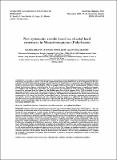Por favor, use este identificador para citar o enlazar a este item:
http://hdl.handle.net/10261/2392COMPARTIR / EXPORTAR:
 SHARE
BASE SHARE
BASE
|
|
| Visualizar otros formatos: MARC | Dublin Core | RDF | ORE | MODS | METS | DIDL | DATACITE | |

| Título: | New systematic results based on chaetal hard structures in Mesochaetopterus (Polychaeta) |
Otros títulos: | Nuevos resultados sistemáticos basados en las quetas de Mesochaetopterus (Polychaeta) | Autor: | Bhaud, Michel; Koh, Byoung-Seoul; Martin, Daniel CSIC ORCID CVN | Palabras clave: | Chaetal hard structures Chaetopterid Annelida Systematics Geographical distribution |
Fecha de publicación: | 30-dic-2006 | Editor: | Consejo Superior de Investigaciones Científicas (España) | Citación: | Scientia Marina 70, S3: 35-44 (2006) | Resumen: | Two kinds of chaetal hard structures have been analysed within the genus Mesochaetopterus (Chaetopteridae, Polychaeta): the specialised chaetae of the fourth segment of the anterior part of the body (i.e. the A4 segment) and the uncinal plates present on neuropodia of mid and posterior parts (i.e. B- and C-regions, respectively). The examination of a large number of specimens leads to identification of finer geographic differences based on the morphological variations of these chaetal hard structures than on criteria linked to the soft body structures. These differences may be considered as species-level markers with a high degree of certainty. As a consequence, the reintroduction of M. sagittarius (Claparède, 1870) is proposed for specimens from the Atlantic and the Mediterranean Sea, while M. minutus (Potts, 1914) is retained for some specimens from the Pacific Ocean. The specimens from the Persian (= Arabian) Gulf seem to be different from those of the Indian Ocean, likely a new species of the genus. Geographic differentiation is also observed over shorter distances and two morphologies of A4 chaetae are identified on specimens from the Solomon’s archipelago, suggesting also the presence of new species. However, other taxonomically valid characters should be explored, in addition to the chaetal hard structures described herein, to formally describe these species. This research adds to the growing literature that suggests truly cosmopolitan species, specifically within the genus Meesochaetopterus and possibly within the Chaetopteridae as a whole, are increasingly difficult to find. Dos clases distintas de estructuras duras se han analizado en el género Mesochaetopterus (Annelida, Polychaeta): las sedas especializadas del cuarto segmento de la región anterior del cuerpo (región A4) y las placas uncinígeras presentes en los neuropodios de las regiones media y posterior (regiones B y C, respectivamente). El estudio de dichas estructuras en un elevado número de ejemplares ha permitido identificar diferencias relacionadas con la distribución geográfica con una mayor precisión que en base a criterios relacionados con las partes blandas de cuerpo. Ciertamente, dichas diferencias pueden considerarse marcadores específicos. Como consecuencia, se propone la reintroducción de M. sagittarius (Claparède, 1870) para las poblaciones atlanto-mediterráneas, mientras que se retiene M. minutus (Potts, 1914) para determinadas poblaciones del Pacífico. Los ejemplares del Golfo Pérsico parecen ser distintos de los del Índico, pudiendo ser probablemente una especie nueva. Diferencias ligadas a la distribución geográfica se han identificado también a una escala espacial menor, concretamente dos morfologías diferentes de la seda modificada A4 en ejemplares de dos poblaciones del Archipiélago de Salomón, lo cual sugiere también la presencia de especies nuevas en la zona. Sin embargo, se considera necesario el estudio de otros caracteres taxonómicamente válidos, además de la estructuras duras de las sedas especializadas y las placas uncinígreras, previamente a proceder a la descripción formal de dichas especies. En resumen, cabe decir que, probablemente en el conjunto de la familia y, ciertamente, en el género Mesochaetopterus la existencia de especies cosmopolitas es cada vez más difícil de ser mantenida. |
Descripción: | Sci. Mar. 70, Suppl. 3 (2006) bears the title: Scientific Advances in Polychaete Research / R. Sardá, G. San Martín, E. López, D. Martin and D. George (eds.) | URI: | http://hdl.handle.net/10261/2392 | ISSN: | 1886-8134 |
| Aparece en las colecciones: | (CEAB) Artículos |
Ficheros en este ítem:
| Fichero | Descripción | Tamaño | Formato | |
|---|---|---|---|---|
| Mesochaetopterus.pdf | 2,12 MB | Adobe PDF |  Visualizar/Abrir |
CORE Recommender
Page view(s)
369
checked on 19-abr-2024
Download(s)
218
checked on 19-abr-2024
Google ScholarTM
Check
NOTA: Los ítems de Digital.CSIC están protegidos por copyright, con todos los derechos reservados, a menos que se indique lo contrario.
